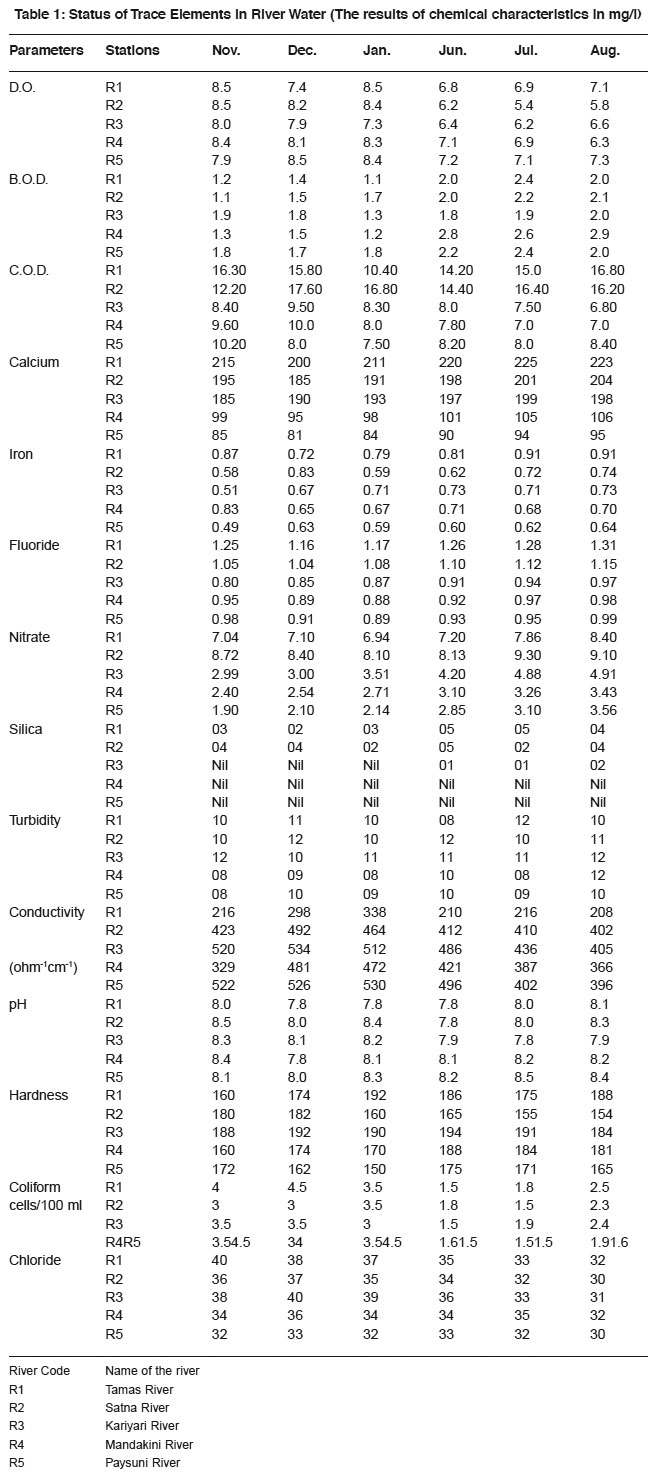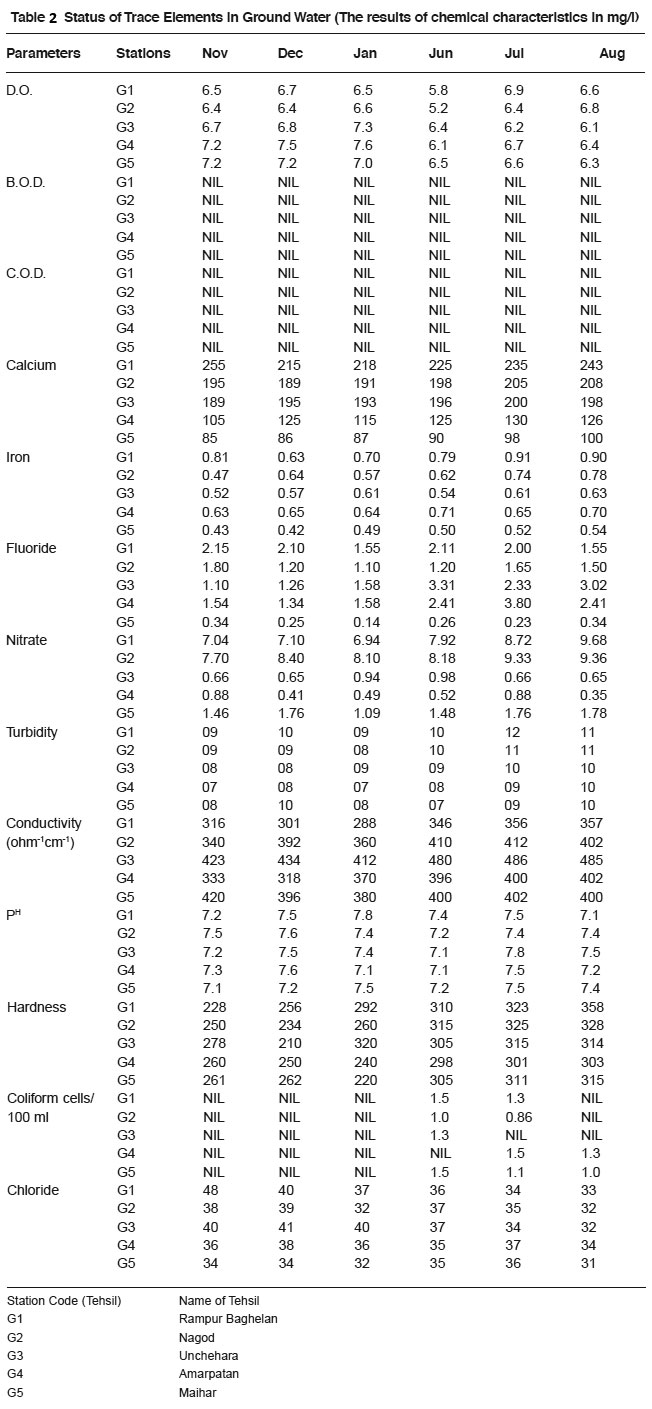Comparative study of trace elements concentration in surface and ground water of Satna region
K.B.L. Shrivastava1 * , S.K. Pandey2 and B.P. Singh3
1
Government Girls College,
Satna,
Madhya Pradesh
India
2
Engineering Chemistry,
VITS,
Satna,
Madhya Pradesh
India
3
Lecturer Chemistry,
Government Girls College,
Satna,
Madhya Pradesh
India
DOI: http://dx.doi.org/10.12944/CWE.3.2.21
Water pollution has become one of the major threat to human health. The safe drinking water is now globally one of the most serious challenges. Water is vital for life, it should be clear, colourless, odourless and should not have any suspended particles as well as harmful and toxic chemical substances. The main aim of this study is to find out the concentration of different trace elements in the water of Satna region by analyzing surface and ground water of this region during different months of the year .This will help in analyzing the effect of season on the concentration of trace metals in the water of this region. A comparative study of concentrations of trace metals will be helpful to take potential health care by taking useful remedial actions.
Copy the following to cite this article:
Shrivastava K.B.L, Pandey S.K, Singh B.P. Comparative study of trace elements concentration in surface and ground water of Satna region. Curr World Environ 2008;3(2):321-326 DOI:http://dx.doi.org/10.12944/CWE.3.2.21
Copy the following to cite this URL:
Shrivastava K.B.L, Pandey S.K, Singh B.P. Comparative study of trace elements concentration in surface and ground water of Satna region. Curr World Environ 2008;3(2):321-326. Available from:http://www.cwejournal.org/?p=861
Download article (pdf)
Citation Manager
Publish History
Select type of program for download
| Endnote EndNote format (Mac & Win) | |
| Reference Manager Ris format (Win only) | |
| Procite Ris format (Win only) | |
| Medlars Format | |
| RefWorks Format RefWorks format (Mac & Win) | |
| BibTex Format BibTex format (Mac & Win) |
Article Publishing History
| Received: | 2008-08-10 |
|---|---|
| Accepted: | 2008-09-20 |
Introduction
The main sources of water pollution in India at present are city sewage, discharge of industrial wastage, intensive use of fertilizers, insecticides and pesticides in agriculture. Excessive use of fertilizers has increased the level of nitrates in shallow ground water sources. The nitrate content in well water in Mahendragarh district in Haryana was found to be as high as 1310 mg/L. In Howrah district, intensive agriculture has contributed to high levels of such pesticides as DDT in the ground water. Satna district abounds in minerals like calcium, iron, aluminium and silicon and their concentration in water has been reported to be positive and in some cases touching the alarming limit of W.H.O. Several industries are set up in this region, prominent among them are lime and cement factories contributing inorganic and organic pollutants.
This paper reports on the drinking water quality of Satna (M.P.) by analyzing 5 samples of river water and 5 samples of ground water collected from different rivers and handpumps.
Methodology
Five samples from different rivers were collected in clear polythene bottles and incubated at normal temperature immediately. In the similar way five samples of ground water were collected in clear polythene bottles. Analysis of several parameters like hardness, fluorides, nitrates, calcium, iron, chloride, turbidity, conductivity, B.O.D and C.O.D as well as MPN of coliforms were conducted within 48 hours of sampling. Analysis of calcium, iron and nitrate was done by simple analytical methods. Calcium was estimated by E.D.T.A complexometric titration method. Estimation of iron was done by redox titration method. B.O.D. was determined by five days B.O.D. determination method. C.O.D. was determined by using Potassium Dichromate as oxidizing agent in acidic medium using FAS solution to determine unused Potassium Dichromate. D.O. was determined by Winkeler’s method. Fluoride concentration was determined spectrophotometrically using SPANDS method while other parameters were determined by APHA (1991) standard methods and results were compared with the standards prescribed so far.
 |
Table 1: Status of Trace Elements in River Water (The results of chemical characteristics in mg/l) Click here to view table |
 |
Table 2: Status of Trace Elements in Ground Water (The results of chemical characteristics in mg/l) Click here to view table |
Results and Discussion
This study has investigated that dissolved oxygen contents of surface water is comparatively more than that of ground water. D.O. contents in months of Nov., Dec. are more than D.O. contents in the months of July and August. B.O.D. and C.O.D values for the surface water are more than that of ground water in all the months of investigation. Although these values are more in rainy season than in winter but B.O.D and C.O.D. values for ground water are nil representing good quality of ground water of this region. Calcium concentration in both the seasons and in both kinds of water exceeds its maximum limit of 75 mg/L ( OSPC board organization) consequently stone patients are reported in this region. The concentration of fluoride in Satna, Unchehara and Nagod Tehsil is above its standard limit of 1.5 mg/l. In Ateraha, Gurhuru and Gorriya of Rampur Tehsil fluoride concentration is 1.25, 2.1 and 2.15 mg/l respectively which is suspicious for fluorosis. Unchehara Tehsil has even 3.31 mg/l concentration of fluoride attracting remedial precautions. Even in Nagod Tehsil fluoride concentration in marha tola 2.05 mg/l which is a matter of anxiety. Nitrate concentrations in surface water is more than that in ground water in both the seasons but its concentration even in ground water in Rampur Tehsil is beyond its maximum permissible concentration. Nitrate ion concentration in rainy season is more indicating uncontrolled use of urea and ammonium sulphate as fertilizers. Iron and fluorides concentration are within the permissible limits. Coliform cells are more in winter than in rainy season and is nil in ground water. Silica is either nil or present in little concentration in Tamas river water. Chloride concentration is much lower in both type of water in both the seasons. On comparing the observations with the permissible limits(BIS&WHO 1989) it is obvious that ground water of Satna is too safe for drinking and domestic purposes but river water needs its treatment for disinfection. Calcium concentration should be minimized because its concentration is more in both types of water in both the seasons. The observations are also compared with observations of MINARS and GEMS and are found within the permissible limits except calcium, nitrate and fluoride. Hardness in ground water in both the seasons is more than the permissible limit.
References
-
W.H.O. Chronical, (1973)27: 534.
-
A.S. Prasad and D.Obereals, Trace elements in human health and devices,Vol.1,The Nutrition Function ACADEMIC PRESS, Newyork, (1976).
-
W.H.O. Chronical (1978) 32: 382.
-
Prasad A.S., Trace elements in human metabolism, Lenum Medical book, Newyork, (1978) 432.
-
Baker, E.L. Landrigan P.J. Field P.H. et al Phenol Poisoning due to contaminated drinking water U.S.A. Arch. Environ. Health (1978) 33(2): 89-94.
-
Singh H.R., Ganga project pollution study of the upper Ganga and its tributaries journal (1988) 11-12: 149-151.
-
Sadhana Chaurasia, Bionature, (1994) 14(2): 131-135.
-
9601 –044Andamutu R. Subhuran A.(Bharathiar Univ. Dept. of Environment Sc. Coimtore –641046), Nitrate concentration in ground water in Tamilnadu Indian journal Environment, Part, (1994) 14(6): 462-467 .
-
9601-048 Chaurasiya Sadhna, (Chitrakoot Gramoday Vishwavidyalya ) Water pollution from mass bathing in river Mandakani during Chitrakoot Deepawali mela 1993. Indian journal, Environment,Part (1994) 14(10): 758-765.
-
9601-051,Gupta A.K.Pathak D.K.(A.P.S. Univ.,Rewa-486003).Resource availability and quality assessment of ground water in rural areas around Rewa, Indian journal Environ. Sc. Part (1994) 14(11): 841-844(6ref.).
-
601-065,Mishra A.Dutta Munshi J.S.,Singh Manish (Univ. Dept.of Chem..T.M.,Bhagalpur Univ.,Bhagalpur-812007.Heavy metal pollution of river Subernrekha in Bihar, Part-1 Industrial effluents,Journal,fresh water Bio, (1994) 6(3): 197-199(11ref.).
-
9703-054,Jain Sanjeev,Gupta S.K.,Salman S.(Barkatullah Univ. Dept. Bhopal-462026).Seasonal change in heavy metals in water and sediments of an eutrophic lake,Indian J-Environ. Sc.. (1996) Part-16(3): (197-202) (ref-17).
-
Singh,Yamuna & Dubey D.P., Analysis of pumping test data from Vindhyan Aquifiers in Rewa Centeral India & it implication for ground water supply Journal of India Academy of Geoscience (1998) 41(1): 57-60.
-
Baruah,B.K., Water quality Ponds in Chandrapur area of Kamarup distt. Assam Environ. Ecology (1998) 16(2): 254-256.
-
Mishra Sanjay., Some studies on water pollution due to mining activities around mining areas of Sahdol (M.P.) (2001).
-
Impact of agricultural modernization on socio-economic status of farmers of Satna Distt. by Sashank Lenka & A.Das Indian Journal of soil conservation (2003) 20(3).






